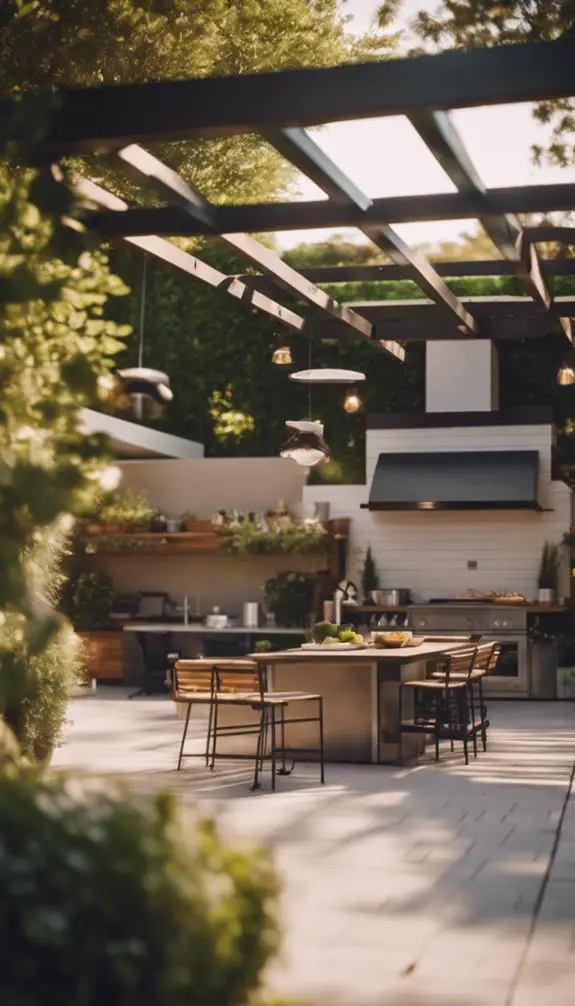You're considering transforming your backyard into a playground haven for your kids. That's a great idea! But where do you start? With so many options available, to guarantee success, prioritize what matters most. You'll want to think about the type of play equipment that will keep your little ones engaged, how to optimize your yard's space, and – most importantly – how to safeguard their safety while they play. As you weigh your options, you'll need to balance your vision with practical considerations like budget and maintenance. Can you create a space that's both fun and functional? Let's examine these key factors together.
Summary
- Customize your backyard playground with innovative equipment that encourages physical activity, social interaction, and imagination, tailored to unique interests and abilities.
- Optimize your yard space by understanding its shape, considering obstacles, and utilizing corner spaces to create a functional and efficient play area.
- Prioritize safety by installing sturdy fencing, rubber surfacing, and impact-absorbing materials, and ensuring compliance with safety standards.
- Design age-appropriate zones that cater to toddlers, preschoolers, and school-age children, with shock-absorbing surfaces, accessible equipment, and distinct play areas.
- Plan your budget by allocating 50% for equipment, 30% for materials, and 20% for labor, and factor in ongoing expenses like maintenance and repairs.
Choosing the Right Play Equipment

As you envision your dream backyard playground, selecting the right play equipment is a crucial step in creating a fun and safe space for kids to thrive.
You'll want to stay on top of the latest play equipment trends, which include innovative designs that encourage physical activity, social interaction, and imagination.
Consider equipment customization to tailor your playground to your children's unique interests and abilities.
With customization options, you can mix and match components to create a one-of-a-kind play space that reflects your family's personality.
From accessible play structures to nature-based play areas, the possibilities are endless.
Yard Size and Space Considerations

When designing your backyard playground, you'll need to ponder the unique challenges and opportunities presented by your yard's size and shape.
You'll want to employ space optimization strategies to guarantee every square foot is used efficiently, and that's where understanding the importance of yard shape comes in.
Space Optimization Strategies
About one-third of households in the United States have a backyard, providing a blank canvas for creating a playground where kids can thrive.
When designing your outdoor space, you'll want to optimize every inch to guarantee maximum fun and functionality.
Start by creating a playground mapping strategy, identifying areas for active play, relaxation, and exploration.
Consider the flow of traffic and how you can create separate zones for different activities.
Outdoor accents like planters, benches, and shade structures can help define these spaces and add visual interest.
Yard Shape Importance
Your backyard's unique shape and size greatly impact the overall functionality of your playground.
You'll need to weigh yard obstacles, such as trees, slopes, and existing structures, to optimize your playground's design. Corner spaces, often underutilized, can be transformed into cozy nooks or functional areas like seating or storage.
Measure your yard carefully, taking note of any irregularities, to create a tailored design that maximizes space. By understanding your yard's dimensions and challenges, you can create a playground that's both fun and functional.
Don't let your yard's limitations hold you back – use them as opportunities to get creative and innovative with your design.
Safety Features to Prioritize

Frequently, backyard playgrounds are designed with excitement and fun in mind, but it's essential to prioritize safety above all else.
You'll want to guarantee that your playground fencing is sturdy and secure, preventing children from wandering off or accessing hazardous areas.
Rubber surfacing is another key safety feature to ponder, as it provides a cushioned fall zone that reduces the risk of injury.
Additionally, you'll want to ponder installing impact-absorbing materials under climbing structures and around swing sets.
Age-Appropriate Playground Design
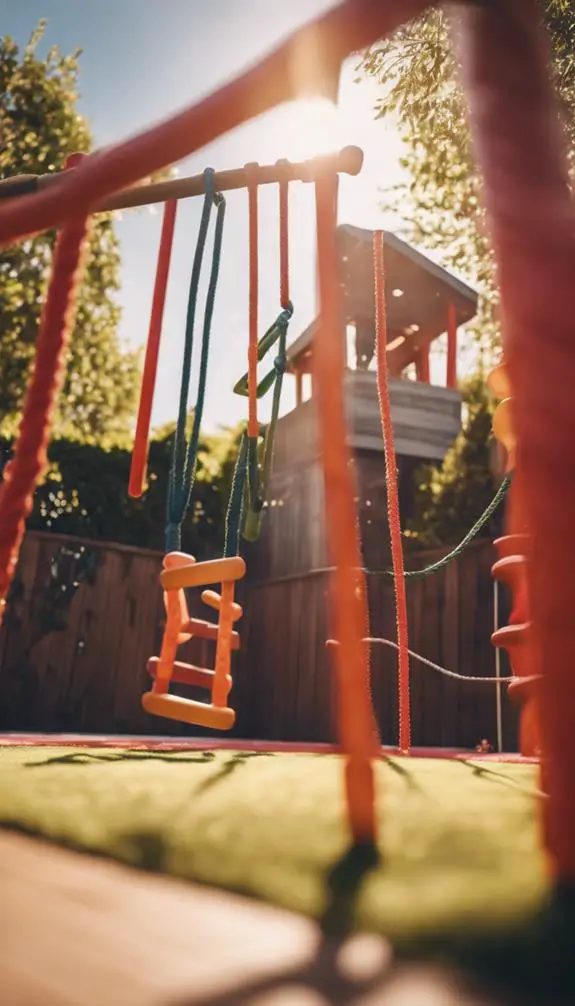
As you design your backyard playground, you're tasked with creating a space that's engaging and safe for kids of different ages.
You'll need to craft a toddler-friendly zone that fosters exploration and discovery, while also creating a safe play area that minimizes risk for kids of all ages.
Toddler-Friendly Zone Design
Within the perimeter of your backyard playground, a toddler-friendly zone design is essential to guarantee the safety and enjoyment of your little ones.
As you design this zone, consider your toddler's interests and incorporate elements that cater to their natural curiosity. Incorporate playful textures like soft rubber, sand, and wood chips to stimulate their sense of touch.
Use bright colors and whimsical designs to capture their attention and encourage exploration. Add interactive elements like sensory bins, bubble walls, and music stations to keep them engaged.
Safe Play Area Creation
Beyond the toddler-friendly zone, a safe play area creation is crucial to guarantee your backyard playground caters to kids of all ages.
As you design this space, consider the play surface, which should be shock-absorbing, slip-resistant, and accessible. You'll want to select materials that meet or exceed safety standards, such as poured-in-place rubber or synthetic turf.
Conduct a safety audit to identify potential hazards, like tripping obstacles or entrapment risks. Certify adequate fall zones around equipment and consider installing impact-absorbing materials, like wood chips or rubber mulch, to reduce injury risks.
Age-Specific Equipment Choices
Three distinct age groups come into play when designing an age-appropriate playground: toddlers (1-3 years), preschoolers (4-5 years), and school-age children (6-12 years).
When choosing play equipment, you'll want to tailor your selection to each age range's unique needs and abilities.
For toddlers, opt for low-to-the-ground play structures with soft, padded surfaces and simple interactive elements.
Preschoolers will enjoy more complex climbing structures and imaginative play features, such as playhouses or puppet theaters.
School-age children will appreciate more challenging play equipment, like rope climbs or suspension bridges, that promote physical activity and social interaction.
DIY Vs Professional Installation
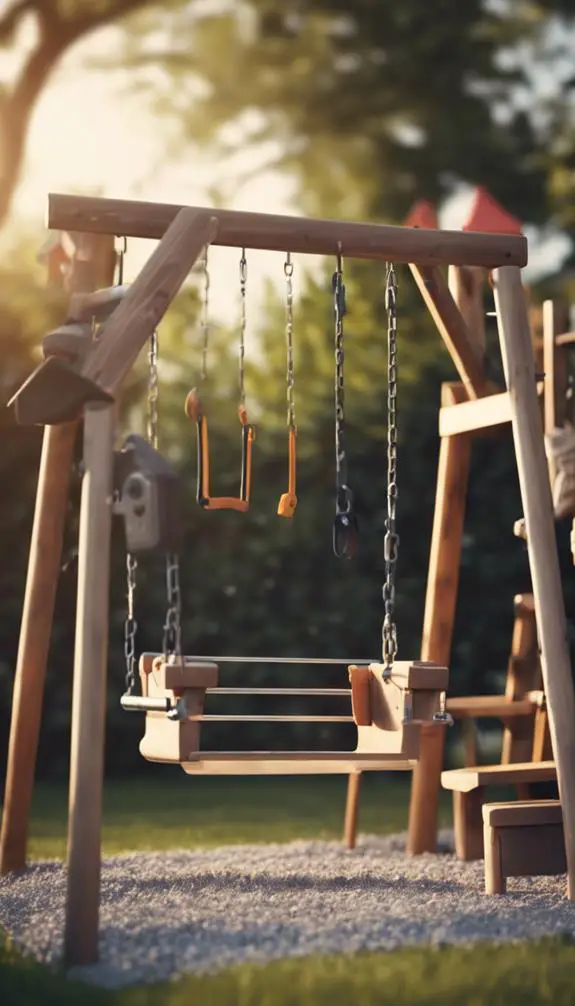
Most homeowners planning to create a backyard playground face a crucial decision: should you take the DIY route or hire a professional to install the equipment?
When considering DIY, you'll need to factor in permit requirements, which can be time-consuming and may require additional inspections.
On the other hand, hiring a professional guarantees compliance with local regulations and often includes warranty considerations, providing peace of mind in case of equipment failure.
Additionally, pros have the expertise to optimize your playground's layout for safety and functionality.
While DIY may seem cost-effective, paramount to weigh the potential risks and consequences against the benefits of a professional installation.
Budgeting for Your Playground
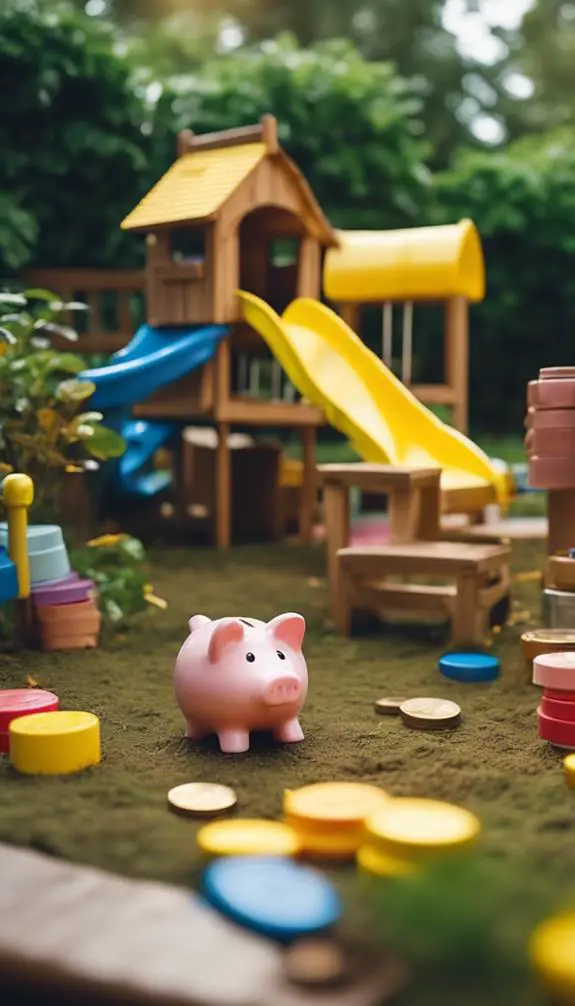
When crafting your backyard playground, a well-planned budget is crucial to bringing your vision to life.
You'll need to ponder the cost of equipment, materials, labor, and any additional features you want to include. A typical playground budget breakdown might allocate 50% for equipment, 30% for materials, and 20% for labor. However, these percentages can vary depending on your specific needs and choices.
Be sure to research different options and get quotes from suppliers to get an accurate estimate of your costs. It's also essential to factor in ongoing expenses, such as maintenance and repairs, to guarantee your playground remains safe and functional over time.
Incorporating Natural Elements

You'll want to thoughtfully select native plants that thrive in your local climate, as they'll require less maintenance and support the local ecosystem.
Incorating rocky outcroppings into your design can create a sense of adventure and exploration, while also providing a unique play surface.
Native Plant Selection
Frequently, homeowners overlook the importance of native plant selection when designing their backyard playground, despite its potential to seamlessly blend natural elements with play areas.
You can create a unique and enchanting atmosphere by incorporating native flowers, which require less maintenance and support local ecosystems.
Consider designing a wild garden, where native plants are allowed to grow freely, creating a natural playground for kids to explore.
By choosing native plants, you'll attract local wildlife, reducing the need for pesticides and fertilizers.
This harmonious blend of natural elements and play areas won't only benefit the environment but also provide a unique and engaging space for kids to learn and play.
Rocky Outcroppings Incorporated
Incorporating rocky outcroppings into your backyard playground design adds a unique, natural touch, inviting kids to explore and engage with the environment.
By incorporating rock formations, you can create a dynamic playscape that encourages physical activity, problem-solving, and creativity.
Consider incorporating bouldering features, such as climbing walls, rocky ledges, or balancing stones, to challenge kids physically and mentally.
You can also use rocks to create natural seating areas, boundaries, or pathways, adding an organic feel to your playground.
When selecting rocks, choose those that are sturdy, weather-resistant, and varied in size and shape to create visual interest.
With careful planning, your rocky outcroppings can become a focal point of your backyard playground.
Tree Canopy Shade
As rocky outcroppings provide a dynamic foundation for your backyard playground, the strategic placement of trees can enhance the space with natural canopy shade, creating an inviting atmosphere that encourages kids to linger and explore.
By carefully selecting tree species with varying canopy layers, you can create a multi-dimensional shade experience. Aim for a tree density of 20-30% to achieve ideal shade coverage.
Consider incorporating deciduous trees, which provide dappled shade during summer months and allow sunlight to filter through during winter. Evergreen trees can add year-round shade and create a sense of enclosure.
Themed Play Areas for Kids
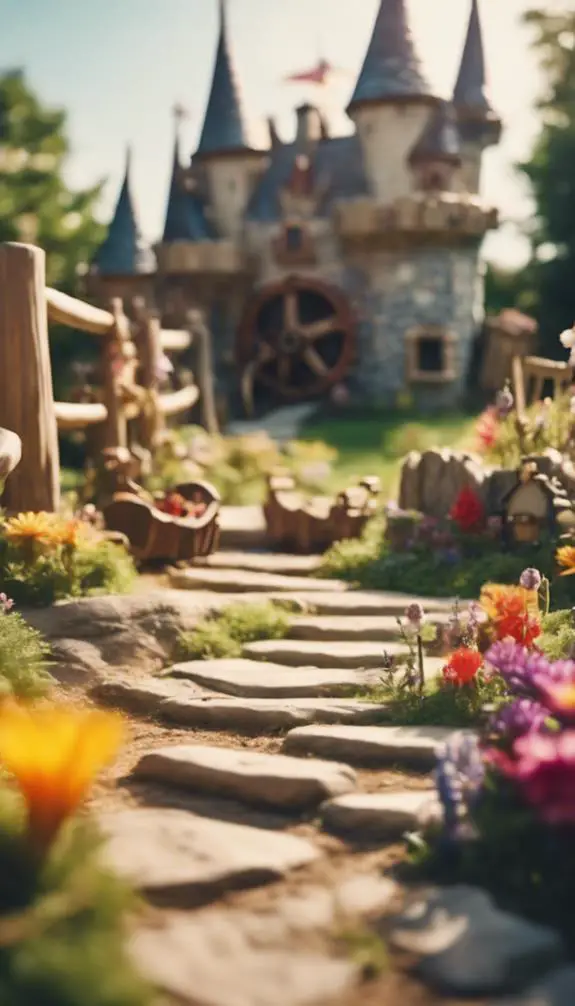
You can create immersive and engaging play experiences for your kids by designing themed play areas in your backyard.
A Pirate's Cove, for instance, can be brought to life with a shipwreck-inspired play structure, treasure chests, and a "walk the plank" feature.
Alternatively, a Fairy Garden can be created with miniature furniture, flowering plants, and a whimsical pathway.
To take it to the next level, consider incorporating sensory elements, such as textured surfaces, water features, or scented plants.
By doing so, you'll create an environment that sparks imagination and encourages creative play.
With careful planning and attention to detail, your backyard can become a magical playground that your kids will cherish.
Swing Sets and Climbing Structures

Moving beyond themed play areas, your backyard playground's functionality takes center stage with the installation of swing sets and climbing structures.
These dynamic components cater to diverse play styles, encouraging kids to explore, experiment, and exercise. Swing variations, such as traditional belt swings, baby swings, and tire swings, provide a range of motion and excitement.
Climbing structures, like rock walls, rope ladders, and cargo nets, challenge kids physically and mentally, promoting strength, agility, and problem-solving skills.
Sandbox and Water Play Options
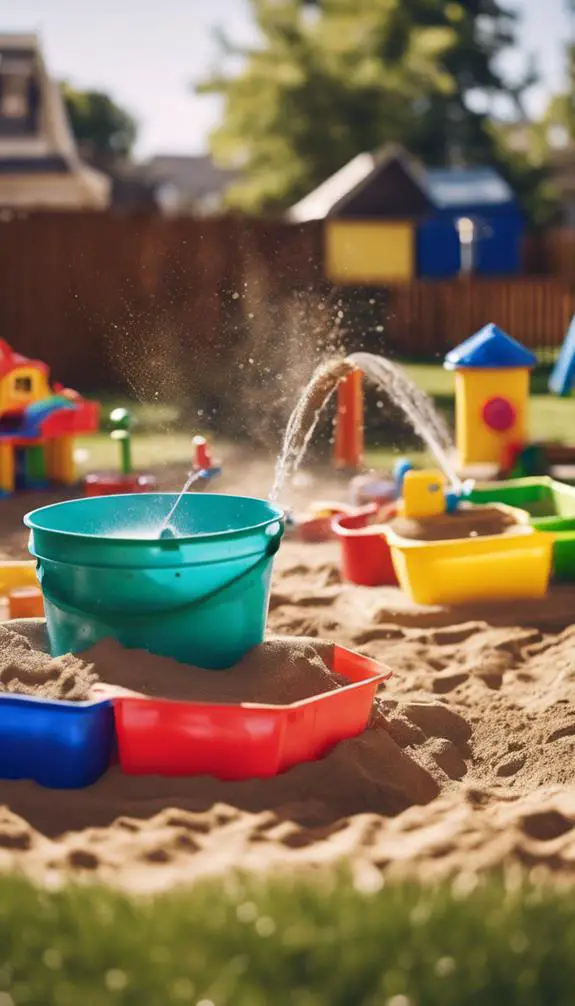
Sandy dunes and watery wonderlands await in your backyard playground, where sandbox and water play options come into play.
You'll create an immersive experience with a sandbox, perfect for digging, building, and exploring.
Add a water table, and kids can engage in hands-on learning, experimenting with fluid dynamics and buoyancy.
Take it to the next level with sensory bins, filled with rice, beans, or sand, and hide small toys or other treasures for kids to discover.
These interactive elements will keep kids enthralled for hours, fostering creativity, problem-solving skills, and a love for nature.
Shade and Seating Areas
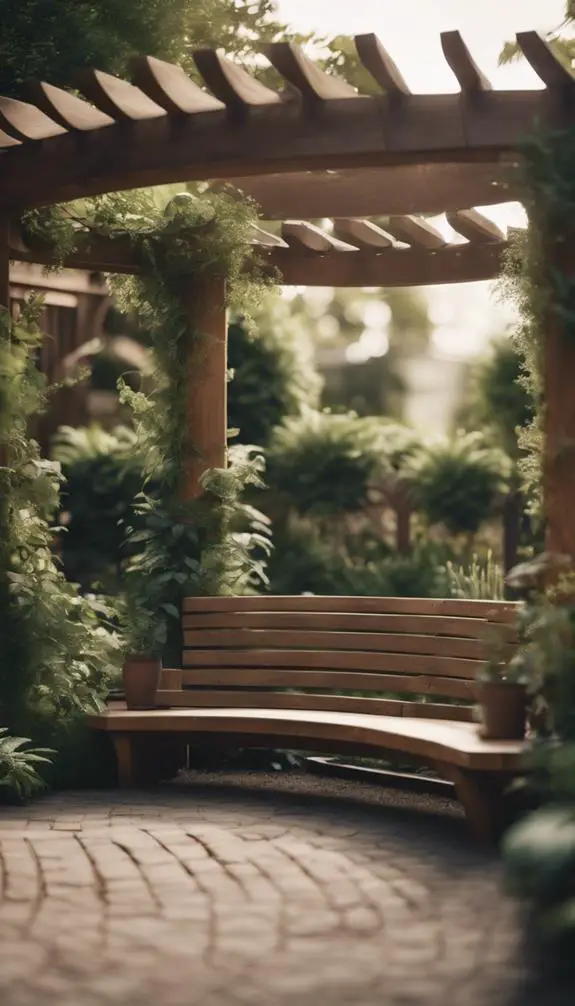
Three essential elements of a backyard playground – safety, comfort, and relaxation – converge in shade and seating areas, where kids can take a break from the sun and recharge for their next adventure.
You can create a shaded oasis using Shade Sails, which provide a stylish and functional way to block out harsh UV rays.
By strategically placing these sails, you can define different zones within your backyard playground.
Incorporate Seating Nooks, such as built-in benches or hammocks, to create cozy spots for kids to relax and socialize.
These areas won't only provide a comfortable respite from the sun but also encourage kids to take breaks, reducing the risk of heat exhaustion and dehydration.
Maintenance and Upkeep Tips
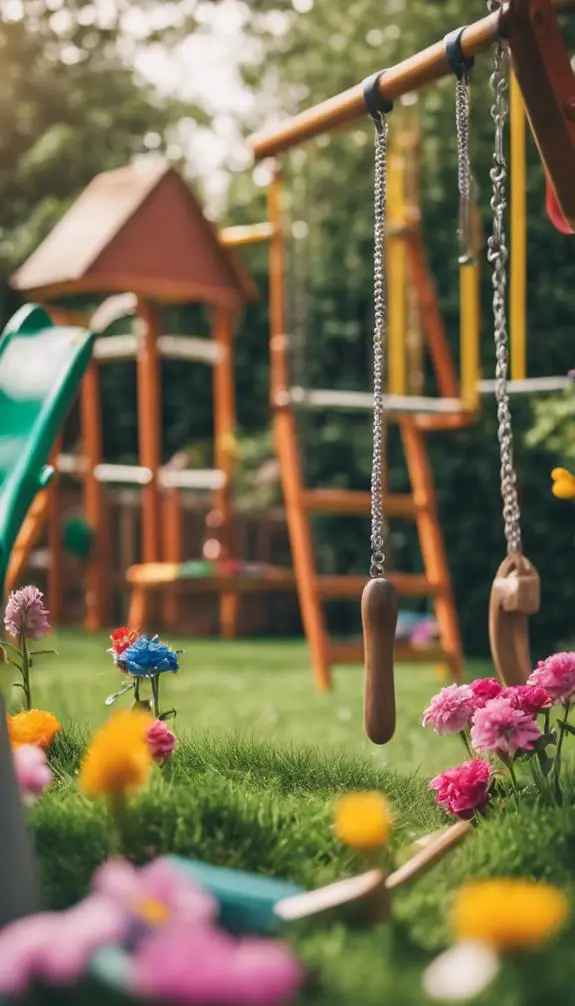
As you've carefully crafted your backyard playground, incorporating essential elements like shade and seating areas, it's pivotal to ponder the behind-the-scenes work that'll keep your outdoor space safe, functional, and fun for kids.
Regular playground inspections are key to identify potential hazards and prevent accidents. Schedule quarterly checks to inspect equipment, surfacing, and fall zones.
Seasonal cleaning is also essential to remove dirt, debris, and mold that can compromise the playground's integrity. Set aside time to power wash surfaces, clean equipment, and replenish mulch or sand.
FAQs
Can I Install a Playground on a Sloping or Uneven Yard?
You can overcome yard challenges by exploring slope solutions, such as terracing or retaining walls, and yard grading to create a level surface, making it possible to install a playground on a sloping or uneven yard.
How Often Should I Inspect My Playground for Maintenance?
You should perform regular safety checks to guarantee your playground remains hazard-free, considering equipment lifespan and manufacturer guidelines, to prevent accidents and prolong the equipment's lifespan, aiming for a thorough inspection every 3-6 months.
Are There Any Eco-Friendly Playground Equipment Options Available?
You'll find eco-friendly playground equipment options that incorporate sustainable materials and recycled plastic, reducing environmental impact while promoting fun and learning; look for manufacturers using recycled HDPE, FSC-certified wood, or repurposed materials in their innovative designs.
Can I Customize My Playground With Personalized Elements?
You can definitely customize your playground with personalized elements, incorporating customized themes that reflect your brand or style, and even adding specialized signage that showcases your unique message, making your space truly one-of-a-kind and tailored to your vision.
Are There Any Playground Equipment Options for Children With Disabilities?
You'll find innovative solutions for kids with disabilities through Accessible Swings, providing wheelchair-accessible seats, and Inclusive Climbers, featuring transfer stations and ramps, allowing all children to participate and thrive in play environments that foster socialization and exploration.
Conclusion
You've successfully designed a backyard playground that's both fun and safe for kids! By choosing the right play equipment, optimizing yard space, and prioritizing safety features, you've created an immersive experience that caters to unique interests and abilities. Remember to maintain and upkeep your playground regularly to guarantee its longevity. With your new playground, kids will be encouraged to explore, learn, and thrive in a space that's uniquely theirs.


